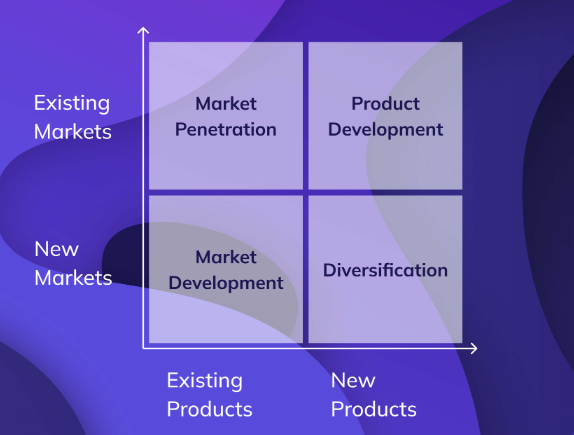What is the Ansoff Matrix?
In today’s dynamic business landscape, strategic planning is paramount for sustainable growth and market dominance. The Ansoff Matrix, devised by Igor Ansoff in 1957, remains a cornerstone framework for businesses aiming to expand and diversify their market reach. In this comprehensive guide, we delve into the intricacies of the Ansoff Matrix, elucidating its components, applications, and strategic implications for businesses across various industries.
Understanding the Ansoff Matrix
The Ansoff Matrix is a strategic planning tool that offers a structured approach to identifying growth opportunities by evaluating market penetration, market development, product development, and diversification strategies. This matrix comprises four quadrants, each representing a distinct growth strategy tailored to address specific business objectives and market conditions.

Each box of the Matrix corresponds to a specific growth strategy. They are:
Market Penetration
Market Penetration strategy focuses on increasing market share within existing markets by promoting existing products to current customers or attracting new customers through aggressive marketing and sales initiatives. This strategy entails leveraging brand equity, optimizing pricing strategies, and enhancing customer engagement to drive sales and revenue growth.
Market Development
Market Development strategy involves expanding into new markets or geographical regions by adapting existing products or services to meet the unique needs and preferences of target audiences. This strategy necessitates conducting market research, identifying lucrative opportunities, and formulating tailored marketing campaigns to penetrate new markets effectively.
Product Development
Product Development strategy centers on innovating and launching new products or services to cater to evolving consumer demands and market trends. This strategy entails investing in research and development (R&D), fostering creativity and innovation, and collaborating with cross-functional teams to conceptualize, design, and commercialize innovative products that resonate with target audiences.
Diversification
Diversification strategy entails entering new industries or market segments by leveraging core competencies, resources, and capabilities to capitalize on untapped opportunities and mitigate risks associated with market saturation or competitive pressures. This strategy requires conducting a comprehensive market analysis, assessing organizational strengths and weaknesses, and formulating strategic partnerships or alliances to facilitate successful diversification initiatives.
Ansoff Matrix and Financial Analysis
There is a widespread misperception that financial analysis is only a quantitative endeavor. The drivers of corporate growth must also be understood by analysts, as they will influence many model assumptions, in addition to the fact that they must be able to interpret assets and liabilities, sift through 10K filings, and create financial models.
What distinguishes elite analysts from the rest is their capacity to convert qualitative results from an Ansoff Matrix, a Porter’s Five Forces framework, or a SWOT or PESTEL analysis into model assumptions.
The ability to model growth drivers well is a crucial component of high-quality due diligence; consequently, these factors can significantly influence credit metrics and valuation estimates.
Conclusion
Ansoff matrix remains a versatile and invaluable tool for businesses aspiring to thrive in the ever-evolving global marketplace. By understanding its core principles, applying its strategic frameworks, and adapting its methodologies to suit specific business contexts and market conditions, organizations can unlock new growth opportunities, capitalize on untapped market potentials, and position themselves for sustained success in the digital age.
FAQ
In “Strategies for Diversification,” Igor Ansoff initially discussed the matrix (Harvard Business Review, September–October 1957, p. 114).
A framework for developing strategies for future corporate growth is offered by the Ansoff matrix, a tool for strategic planning that is used by executives, senior managers, and marketers. It bears the name of its inventor, Russian-American business manager and applied mathematician Igor Ansoff.
Igor Ansoff created the Ansoff matrix in 1965, which is used to create strategic choices for companies.
It supports methodical and innovative thinking about various corporate growth strategies. It pushes you to think beyond the box and examine fresh possibilities.
Coca-Cola is one business that has successfully applied the Ansoff Matrix. H. Igor Ansoff created the Ansoff Matrix, a strategic tool that aids companies in organising their growth plans by taking into account the possibilities of product creation, market penetration, market development, and diversification.
Advantages: Easy to use and comprehend, aids in educating stakeholders about the degree of risk involved in various strategies. Potential drawbacks: Accurate prediction is difficult, and it isn’t a stand-alone instrument.
Want to subscribe to latest lectures by Parag Gupta sir?






